Welcome to the Basic Life Support (BLS) algorithms and training by United Medical Education. Here we will discuss basic life saving interventions for patients in respiratory and cardiac distress and the importance of teamwork in a medical emergency. The life saving interventions of BLS are primarily for the purpose of maintaining circulation and oxygenation of the brain and other vital organs until Advanced Cardiac Life Support (ACLS) and other interventions can be initiated by trained healthcare providers.
Welcome to the free BLS algorithm page offered by United Medical Education. Here you will be able to review critical interventions needed to save a life and earn your BLS provider card. Learn more about our BLS certification and build a free student account.
Need BLS Certification?
It’s Trusted by Over 100,000+ Students
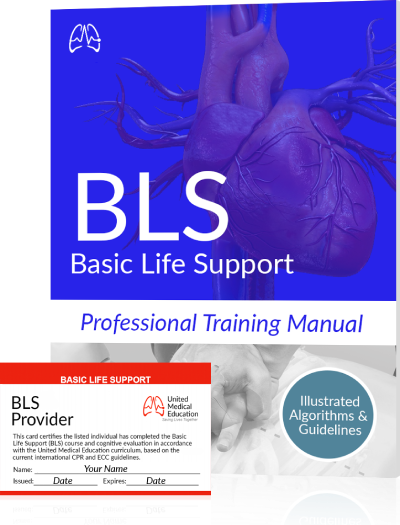
Register for BLS Certification
$85
Register for BLS Recertificaiton
$85
CPR: for adults
CABD (Circulation, Airway, Breathing, Defibrillate)
There is a common acronym in BLS used to guide providers in the appropriate steps to assess and treat patients in respiratory and cardiac distress. This is CAB-D (Circulation, Airway, Breathing, Defibrillate). The following scenario will help guide you in performing CAB-D.
You find an adult lying on the ground.
Assess to make sure the scene is safe for you to respond to the down patient.
Assess Responsiveness: Stimulate and speak to the adult asking if they are ok. Look at the chest and torso for movement and normal breathing.
If unresponsive:
- (One provider) first call the emergency response team and bring an AED to the patient.
- (Two providers) Have someone near call the emergency response team and bring the AED.
Place patient supine on a hard flat surface.
Circulation
- Check the patient for a carotid pulse for 5-10 seconds. (Do not check for more than 10 seconds.)
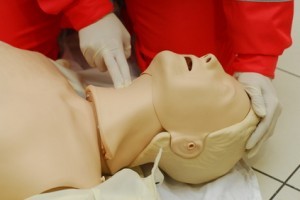
If the patient has a pulse:
Move to the airway and rescue breathing portion of the algorithm:
- Provide 10 rescue breaths per minute (1 breath every 6 seconds).
- Recheck pulse every 2 minutes.
If the patient doesn’t have a pulse:
Begin 5 cycles of CPR (lasts approximately 2 minutes).
Start with chest compressions:
- Provide 100 to 120 compressions per minute. This is 30 compressions every 15 to 18 seconds.
- Place your palms midline, one over the other, on the lower 1/3 of the patient’s sternum between the nipples.
- lock your arms.
- Using two arms press to a depth of 2 to 2.4 inches (5-6cm) or more on the patient’s chest.
- Press hard and fast.
- Allow for full chest recoil with each compression.
1 cycle of adult CPR is 30 chest compressions to 2 rescue breaths.
If two providers are present: switch rolls between compressor and rescue breather every 5 cycles.
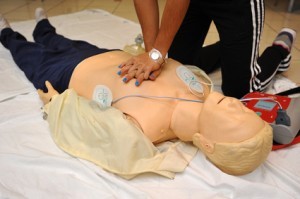
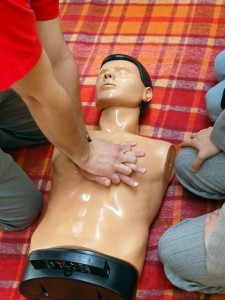
Airway
In the event of an unwitnessed collapse, drowning, or trauma:
Use the Jaw Thrust maneuver. (This maneuver is used when a cervical spine injury cannot be ruled out.):
- Place your fingers on the lower rami of the jaw.
- Provide anterior pressure to advance the jaw forward.
In the event of a witnessed collapse with no reason to assume a C-spine injury:
Use the Head Tilt-Chin Lift maneuver:
- place your palm on the patient’s forehead and apply pressure to tilt the head backward.
- place the fingers of your other hand under the mental protuberance of the chin and pull the chin forward and cephalic.
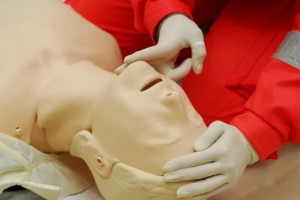
Breathing
Scan the patients chest and torso for possible movement during the “assess unresponsiveness” portion of the algorithm. Watch for abnormal breathing or gasping.
If the patient is breathing adequately:
Continue to assess and maintain a patent airway and place the patient in the recovery position. (Only use the recovery position if its unlikely to worsen patient injury.)
If the patient is not breathing or is breathing inadequately:
If the patient has a pulse:
- Commence rescue breaths immediately.
If the patient has no pulse:
- Begin CPR. (move to the “Circulation” portion of the algorithm.)
- Use a barrier device if available.
- Pinch the patient’s nose closed.
- Make a seal using your mouth over the mouth of the patient or use a pocket mask or bag mask.
- Each rescue breath should last approximately 1 second.
- Watch for chest rise.
- Allow time for the air to expel from the patient.
During normal CPR without an advanced airway:
- Provide approximately 6-8 rescue breaths per minute
During normal CPR with an advanced airway:
- Provide 10 rescue breaths per minute (don’t pause chest compressions for breaths).
If patient has a pulse and no CPR is required:
- Provide 10 rescue breaths per minute (1 breath every 6 seconds).
- Recheck pulse every 2 minutes.
If there is a foreign body obstruction:
- Perform abdominal thrusts
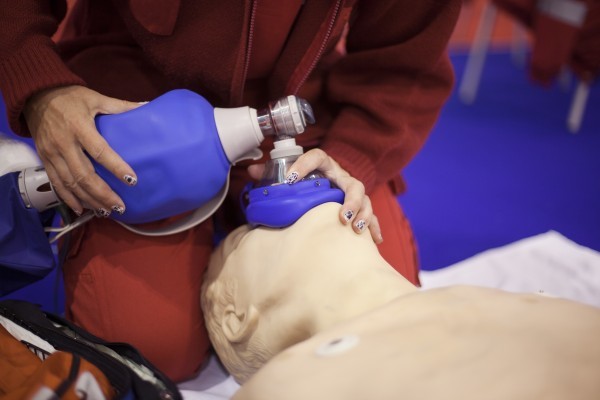
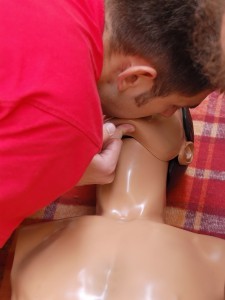
Recovery position
(lateral recumbent or 3/4 prone position):
This position is used to maintain a patent airway in the unconscious person.
- place the patient close to a true lateral position with the head dependent to allow fluid to drain.
- Assure the position is stable.
- Avoid pressure of the chest that could impairs breathing.
- Position patient in such a way that it allows turning them onto their back easily.
- Take precautions to stabilize the neck in case of cervical spine injury.
Continue to assess and maintain access of airway.
Avoid the recovery position if it will sustain injury to the patient.
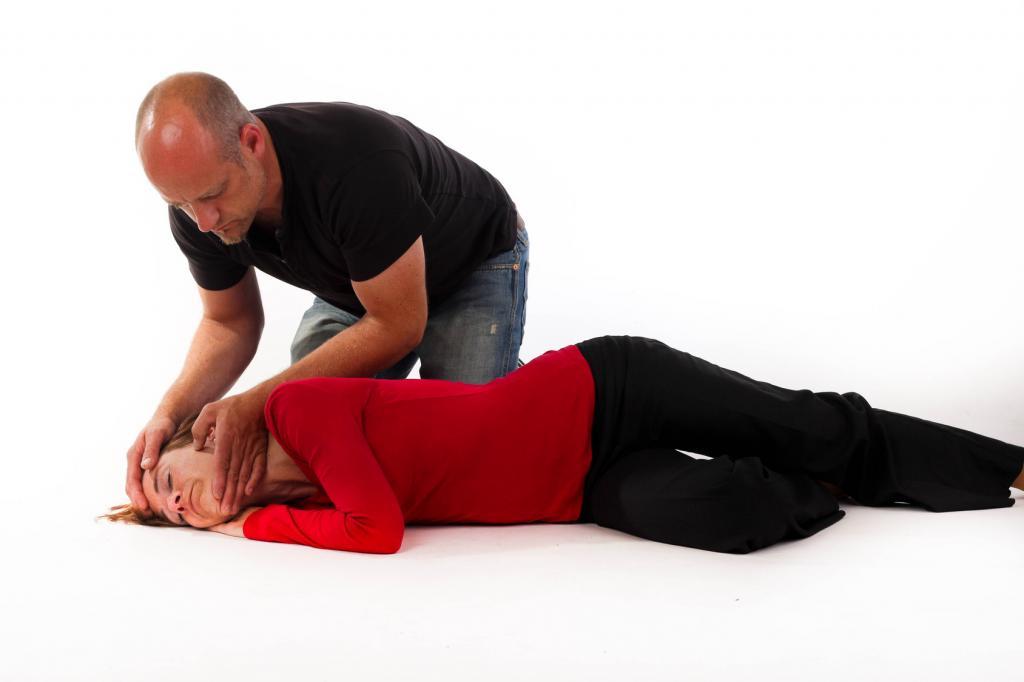
Defibrillate
Arrival of the AED (Automated External Defibrillator)
Power:
- Turn AED On NOW! (early defibrillation is the single most important therapy for survival of cardiac arrest and should be done as soon as it arrives).
- Follow verbal AED prompts.
Attachment:
- Firmly place appropriate pads (adult/pediatric) to patient’s skin to the indicated locations (pad image).
Analyze:
A short pause in CPR is required to allow the AED to analyze the rhythm.
If the rhythm is not shockable:
- Initiate 5 cycles of CPR.
- Recheck the rhythm at the end of the 5 cycles of CPR.
If the shock is indicated:
- Assure no one is touching the patient or is in mutual contact of a good conductor of electricity by yelling “Clear, I’m Clear, you’re Clear!” prior to delivering a shock.
- Press the shock button when the providers are clear of the patient.
- Resume 5 cycles of CPR.
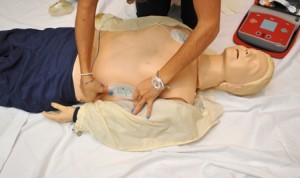
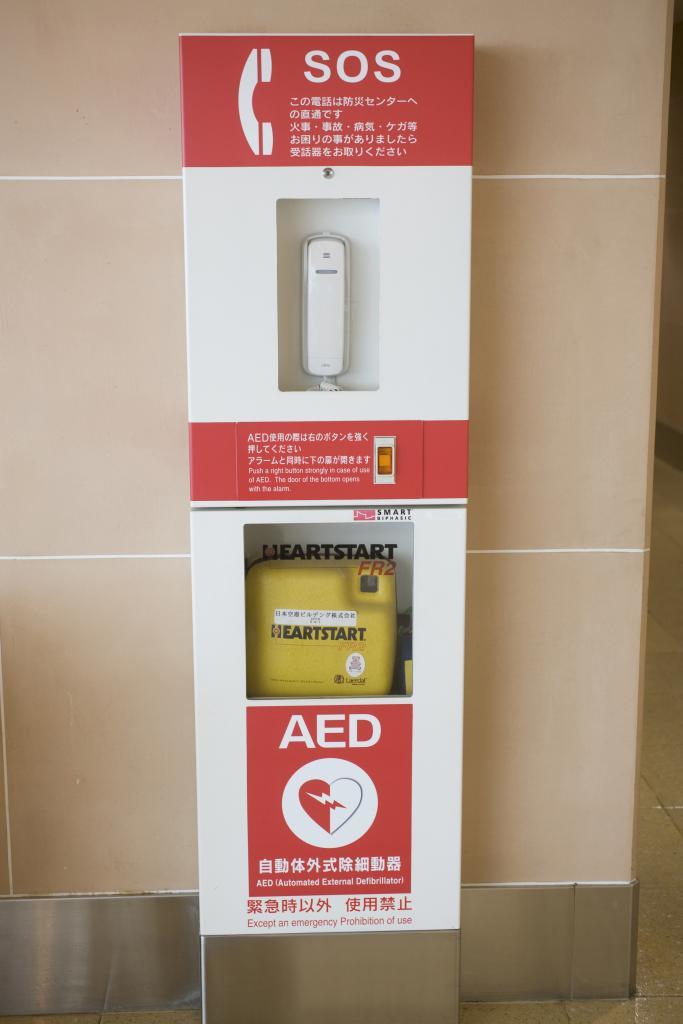
CPR: for infants 0-1 in age
CABD (Circulation, Airway, Breathing, Defibrillate)
An infant is found lying on the ground.
Assess to make sure the scene is safe for you to respond to the down patient.
Assess Unresponsiveness: Lightly shake or tap the infant’s foot and say their name. Look at the chest and torso for movement and normal breathing.
If the infant is unresponsive:
- (One provider) If alone and collapse is un-witnessed: First perform 2 minutes of CPR then call the emergency response team and bring an AED to the patient.
- (One provider) If alone and collapse is witnessed: First call the emergency response team and bring an AED, then start CPR.
- (Two providers) Have someone near call the emergency response team and bring the AED and you start CPR.
- Place patient supine on a hard flat surface.
Circulation
Feel for either the brachial or femoral pulse (Do not check for more than 10 seconds).
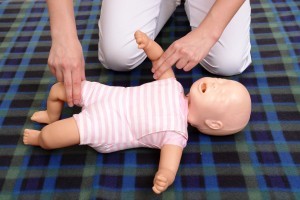
If the infant has a pulse:
Move to the airway and rescue breathing portion of the algorithm.
- Give 12-20 breaths per minute.
- Recheck the pulse every 2 minutes.
If the infant doesn’t have a pulse:
Begin 5 cycles of CPR (lasts approximately 2 minutes).
Start with Chest Compressions:
- Provide 100 to 120 compressions per minute. This is 30 compressions every 15 to 18 seconds.
- (One provider) Place two fingers on the sternum of the lower chest. One between the nipple line and the other 1cm below.
- (Two providers) Encircle the infant’s torso with both hands with both thumbs pointing cephalic positioned 1cm below the nipples over the sternum.
- Chest Compressions should be at least 1.5 inches or 1/3 the depth of infant’s chest.
- Press hard and fast.
- Allow for full chest recoil.
- Only allow minimal interruptions to the chest compressions.
(One Provider: 1 cycle is 30 chest compressions to 2 rescue breaths) (Two Providers: 1 cycle is 15 chest compressions to 2 rescue breaths)
If you have two providers: switch rolls between compressor and rescue breather every 2 minutes or 5 cycles of CPR.
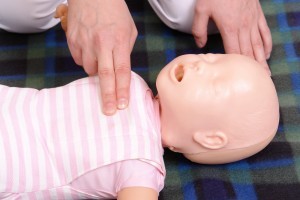
Airway
In the event of an unwitnessed collapse, drowning, or trauma:
Use the Jaw-Thrust maneuver. (This maneuver is used when cervical spine injury cannot be ruled out.):
- Place your thumbs on the upper cheek bones of the infant.
- Place your fingers on the lower rami of the jaw.
- Provide anterior pressure to advance the jaw forward.
In the event of a witnessed collapse and there’s no reason to assume C-spine injury:
Use the Head Tilt-Chin Lift maneuver:
- place your palm on the patient’s forehead and apply pressure to tilt the head backward.
- place the fingers of your other hand under the mental protuberance of the chin and pull the chin forward and cephalic.
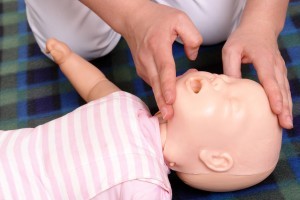
Breathing
Scan the patients chest and torso for possible movement during the “assess unresponsiveness” portion of the algorithm. Watch for abnormal breathing or gasping.
If the infant has adequate breathing:
- Continue to assess and maintain a patent airway and place the infant in the infant recovery position. (Only use the recovery position if its unlikely to worsen patient injury)
If the infant is not breathing or is inadequately breathing:
If the infant has a pulse:
- commence rescue breaths immediately.
If the infant doesn’t have a pulse:
- begin CPR (go to Circulation portion of the algorithm).
- Use a barrier device if available.
- Make a seal using your mouth over the mouth and nose of the patient.
- Each rescue breath should be small and last approximately 1 second.
- Watch for chest rise.
- Allow time for the air to expel from the patient.
During normal CPR with an advanced airway:
- Provide 12-20 rescue breaths per minute (do not stop chest compressions for rescue breaths).
If the patient has a pulse and no CPR is required:
- Provide 12-20 rescue breaths per minute.
- Recheck pulse every 2 minutes.
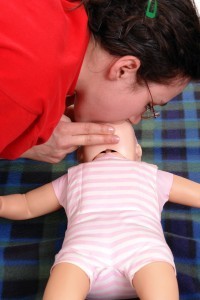
Recovery position for infants
- Cradle the infant with the infant’s head tilted downward and slightly to the side to avoid choking or aspiration.
- Continually check the infants breathing, pulse, and temperature.
Defibrillate
Arrival of AED (Automated External Defibrillator)
Power:
- Turn AED On NOW! (early defibrillation is the single most important therapy for survival of cardiac arrest. Begin use on patient as soon as it arrives).
- Follow verbal AED prompts.
Attachment:
- Firmly place appropriate pads (adult/pediatric) to patient’s skin to the indicated locations (pad image).
Analyze:
A short pause in CPR is required to allow the AED to analyze the rhythm.
If the rhythm is not shockable:
- Initiate 5 cycles of CPR.
- Recheck the rhythm at the end of the 5 cycles of CPR.
If shock is indicated:
- Assure no one is touching the patient or in mutual contact of a good conductor of electricity by yelling “Clear, I’m Clear, you’re Clear!” prior to delivering a shock.
- Press the shock button when the providers are clear of the patient.
- Resume 5 cycles of CPR.
Manual defibrillators are preferred for infant use. If the manuals defibrillator is not available the next best option is an AED with a pediatric attenuator. An AED without a pediatric attenuator can also be used.
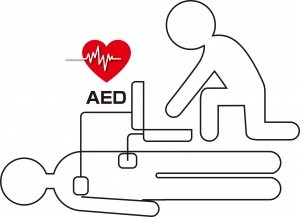

CPR: for a child older than 1 year of age to puberty
CABD (Circulation, Airway, Breathing, Defibrillate)
You find a child lying on the ground.
Assess to make sure the scene is safe for you to respond to the down patient.
Assess Unresponsiveness:
- Stimulate and speak to the child.
- Look at the chest and torso for movement and normal breathing.
If unresponsive:
(One provider) If alone and collapse is un-witnessed:
- Perform 2 minutes of CPR first then call the emergency response team and bring an AED to the patient.
If alone and collapse is witnessed:
- (one provider) Call the emergency response team and bring an AED first, then start CPR.
- (two providers) Have someone near call the emergency response team and bring the AED.
- (two providers) You start CPR.
Place patient supine on a hard flat surface.
Circulation
- Check the patient for a carotid pulse for 5-10 seconds.

If pulse:
Move to the airway and rescue breathing portion of the algorithm:
- Provide 12-20 rescue breaths per minute.
- Recheck pulse every 2 minutes.
If no pulse:
Begin 5 cycles of CPR (lasts approximately 2 minutes)
Start with chest compressions:
- Provide 100 to 120 compressions per minute. This is 30 compressions every 15 to 18 seconds.
- Use one or two arms.
- Place one or both of your palms midline, one over the other, on the lower sternum, between the nipples.
- Press at least to 1/3 the depth of patient’s chest or 2 inches.
- Press hard and fast.
- Allow for full chest recoil with each compression.
- Allow for only minimal interruptions to chest compressions.
(One Provider: 1 cycle is 30 chest compressions to 2 rescue breaths) (Two Providers: 1 cycle is 15 chest compressions to 2 rescue breaths)
If you have two providers: switch rolls between compressor and rescue breather every 2 minutes or 5 cycles of CPR.
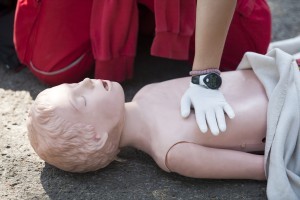

Airway
In the event of an unwitnessed collapse, drowning, or trauma: Use the Jaw-Thrust maneuver. (this maneuver is used when cervical spine injury cannot be ruled out):
- Place your fingers on the lower rami of the jaw.
- Provide anterior pressure to advance the jaw forward.
In the event of a witnessed collapse and there’s no reason to assume a C-spine injury: Use the Head Tilt-Chin Lift maneuver.
- place your palm on the patient’s forehead and apply pressure to tilt the head backward.
- place the fingers of your other hand under the mental protuberance of the chin and pull the chin forward and cephalic.
Breathing
Scan the patients chest and torso for possible movement during the “assess unresponsiveness” portion of the algorithm. Watch for abnormal breathing or gasping that will require additional ventilatory support.
If adequate breathing:
Continue to assess and maintain a patent airway and place the child in the recovery position. (Only use the recovery position if its unlikely to worsen patient injury)
If not or inadequate breathing:
has a pulse: Commence rescue breaths immediately.
no pulse: Begin CPR (go to Circulation portion of the algorithm).
- Use a barrier device if available.
- Pinch the patient’s nose closed.
- Make a seal using your mouth over the mouth of the patient.
- Each rescue breath should last approximately 1 second.
- Watch for chest rise.
- Allow time for the air to expel from patient.
During normal CPR without an advanced airway:
(One provider) Provide at least 6 rescue breaths per minute.
(Two provider) Provide at least 12 rescue breaths per minute.
During normal CPR with an advanced airway:
- Provide 12-20 rescue breaths per minute (do not stop chest compressions for rescue breaths).
If patient has a pulse and no CPR is required:
- Provide 12 -20 rescue breaths per minute.
- Recheck pulse every 2 minutes.
If foreign body obstruction:
- Perform abdominal thrusts.


Recovery position (lateral recumbent or 3/4 prone position)
This position is used to maintain a patent airway in the unconscious person.
- place the patient close to a true lateral position with the head dependent to allow fluid to drain.
- Assure the position is stable.
- Avoid pressure of the chest that could impairs breathing.
- Position patient in such a way that it allows turning them onto their back easily.
- Take precautions to stabilize the neck in case of cervical spine injury.
- Continue to assess and maintain access of airway.
- Avoid the recovery position if it will sustain injury to the patient.
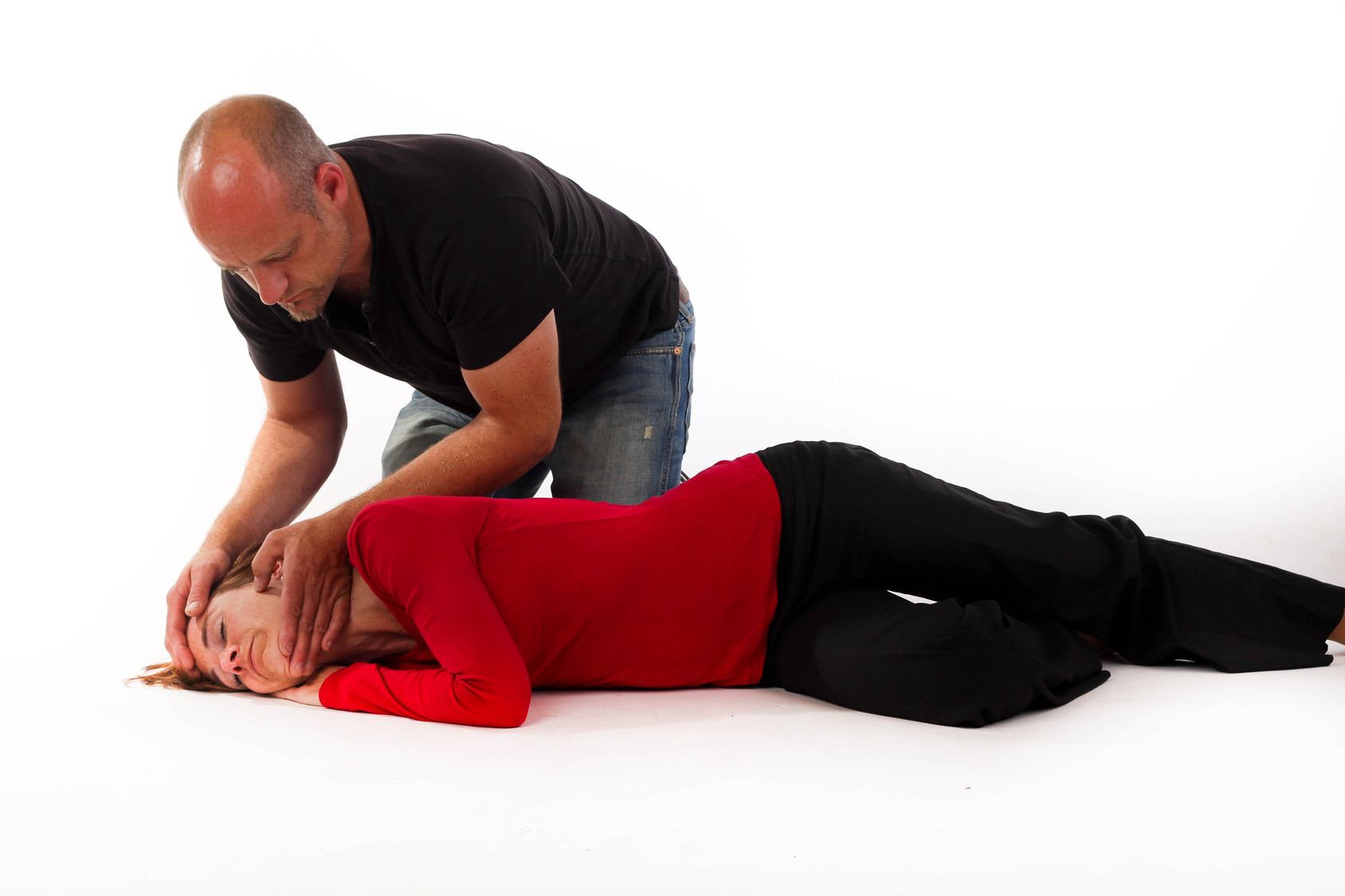
Defibrillate
Arrival of AED (Automated External Defibrillator)
Power:
- Turn AED On NOW! (early defibrillation is the single most important therapy for survival of cardiac arrest. Use immediately upon its arrival to the scene).
- Follow verbal AED prompts.
Attachment:
- Firmly place appropriate pads (adult/pediatric) to patient’s skin to the indicated locations (pad image).
Analyze:
A short pause in CPR is required to allow the AED to analyze the rhythm.
If rhythm is not shockable:
- Initiate 5 cycles of CPR.
- Recheck the rhythm at the end of the 5 cycles of CPR.
If shock is indicated:
- Assure no one is touching the patient or in mutual contact of a good conductor of electricity by yelling “Clear, I’m Clear, you’re Clear!” prior to delivering a shock.
- Press the shock button when the providers are clear of the patient.
- Resume 5 cycles of CPR.
An AED with a pediatric attenuator should be used in children under 8 years of age if available. An AED without a pediatric attenuator can also be used.
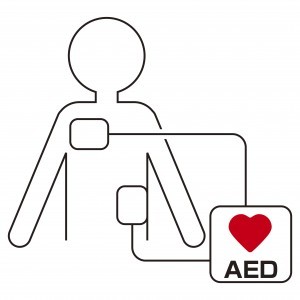
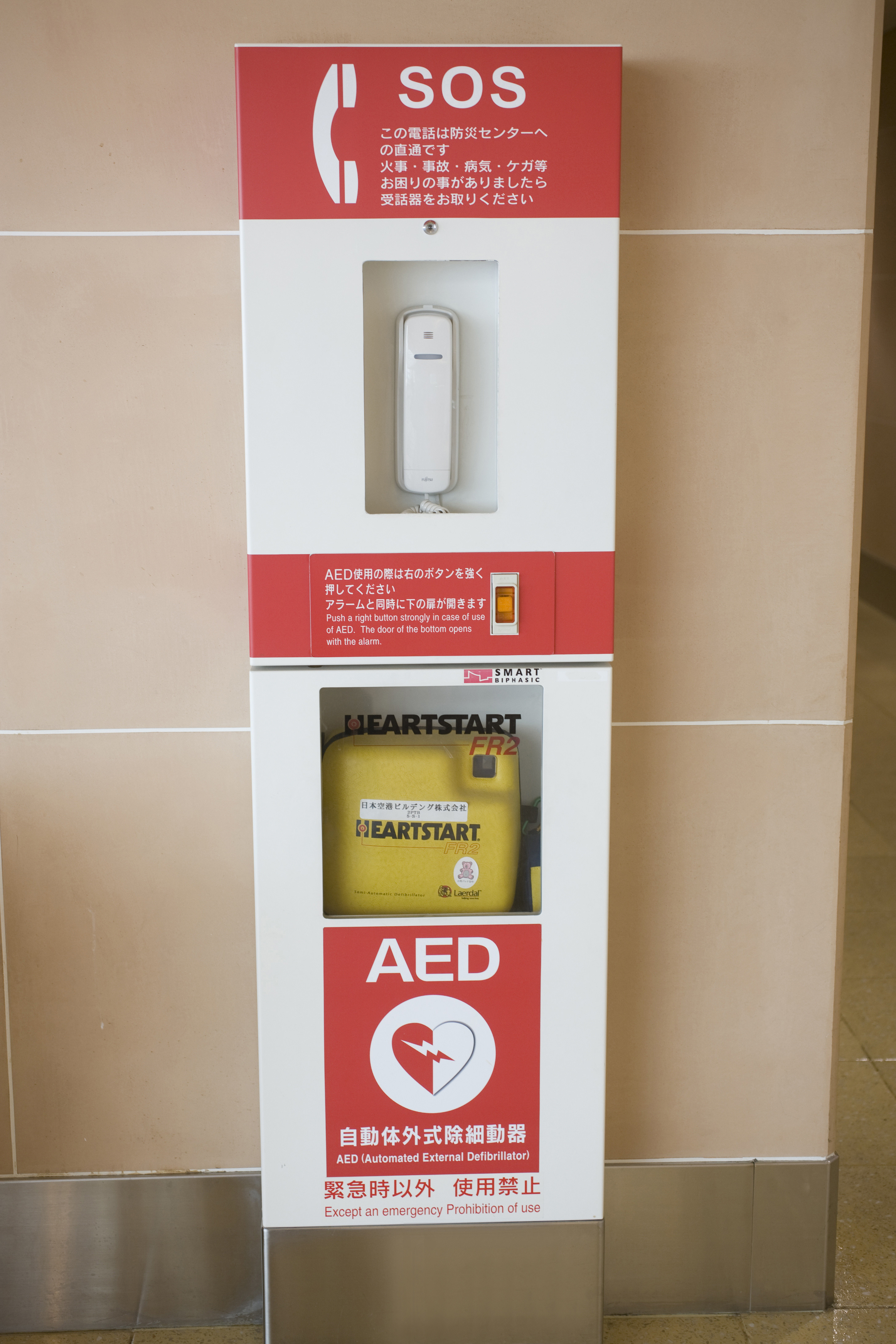
Choking: Adult to Child Over 1 Year Old
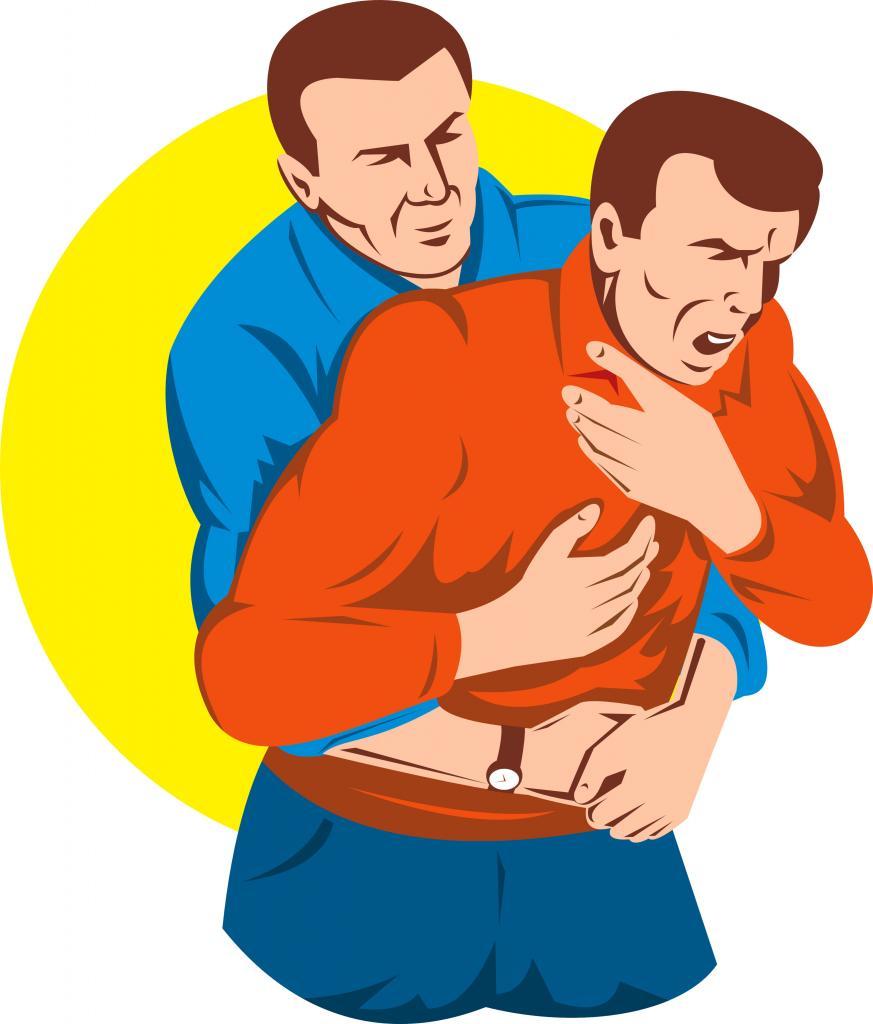
Signs and symptoms of a child/adult choking:
Universal signal for choking:
patient has both hands wrapped around the base of their throat.
With complete airway obstruction, the child is unable to speak, cry, or provide any sounds of respiration.
The patient may be confused, weak, obtunded, or cyanotic.
Partial airway obstruction may result in stridor or a high-pitched audible noise during respiration. Partial airway obstruction may allow for a productive cough or allow the patient to speak.
Get the patient’s attention and ask them if they are choking.
Assess for signs and symptoms of airway obstruction.
If partial airway obstruction:
- Do not attempt Heimlich maneuver.
If complete airway obstruction:
- (one provider) immediately call the emergency response team.
- (one provider) Attempt Heimlich maneuver
- (two provider) Send someone to call the emergency response team, while you attempt the Heimlich maneuver.
How to perform the Heimlich maneuver:
- Stand directly behind the child/adult.
- Place both of your arms around patient’s waist.
- Make a fist with one hand and grab the fist with opposite hand.
- Position the thumb end of the fisted hand immediately above the patient’s naval (ample distance away from the xiphoid process).
- Perform fast upward and inward diaphragmatic abdominal thrusts.
- Continue abdominal thrusts until the obstruction is removed.
If patient becomes unconscious:
- Initiate CPR.
Before attempting rescue breaths during normal CPR, assess the airway, removing any visually present obstruction.
Do not use a blind finger sweep in an attempt to remove an obstruction.
Choking: Infant Under 1 Year Old
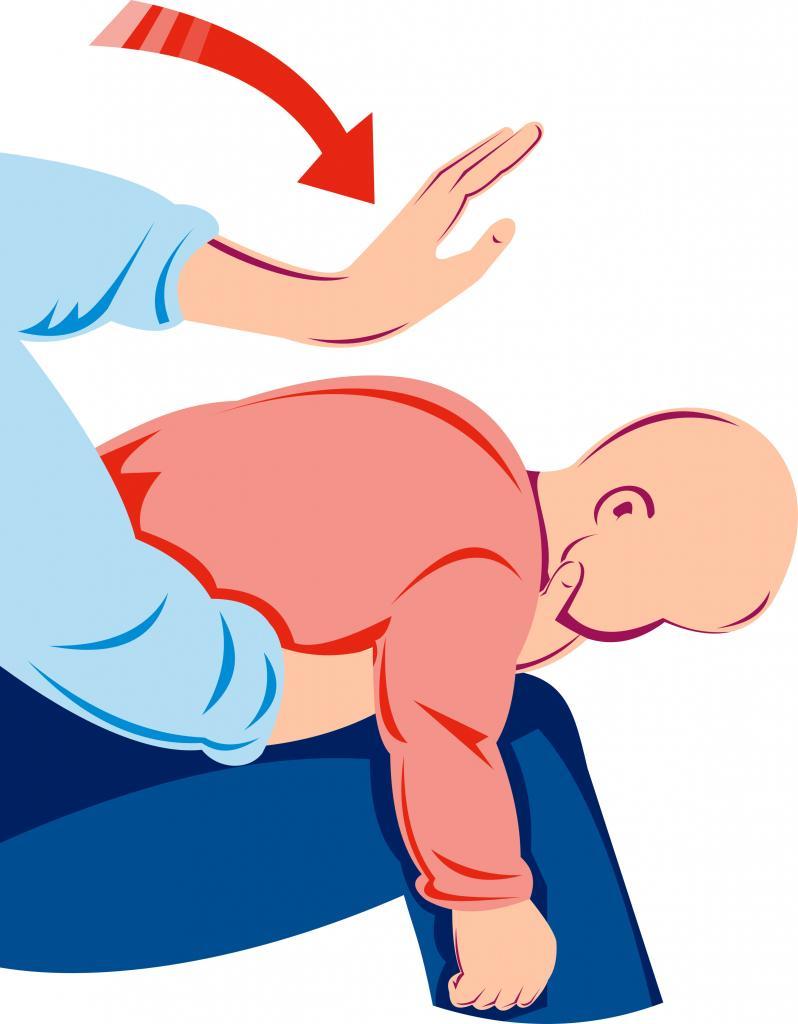
Signs and symptoms of an infant choking:
With complete airway obstruction, the infant is unable to speak, cry, or provide any sounds of respiration. The infant may be confused, weak, obtunded, or cyanotic.
Partial airway obstruction may result in stridor or a high-pitched audible noise during respiration. If the child has a partial airway obstruction, powerful cough, or strong audible cry, do not attempt the Heimlich maneuver.
If signs and symptoms of choking are present and infant is conscious:
- (one provider) immediately call the emergency response team.
- (one provider) Assess the airway for any visually present obstruction and manually remove it if possible.
- (two provider) Send someone to call the emergency response team while you assess the airway.
- Never use a blind finger sweep.
Position the patient:
- Lay infant’s face and torso down on forearm (prone) with chest being supported by your palm and their head and neck by your fingers.
- Tilt the infant’s body at a 30 degree angle, head downward (trandelenburg).
- Use your thigh or other object for support.
Interventional Back Blows:
- Provide 5 rapid forceful blows using a flat palm on the infant’s back between the two scapula.
Reposition the patient:
- Rotate the infant face up (supine), head downward (trandelenburg) by switching the infant to the opposite arm.
Interventional Chest Thrusts:
- Place your two fingers on the center of the infant’s sternum immediately below the nipple line.
- Provide 5 rapid compressions, with thrusts equaling 1/3 to 1/2 the total depth of the chest.
- Continue cycling back and forth between interventional back blows and chest thrusts until the obstruction is removed or until consciousness is lost.
If becomes unconscious:
- Initiate CPR.
- Before attempting rescue breaths during normal CPR, assess the airway, removing any visually present obstruction.
- Do not use a blind finger sweep in an attempt to remove an obstruction.
Congratulations!
You’re Ready to Certify.

Register for BLS Certification
$85
Register for BLS Recertificaiton
$85
